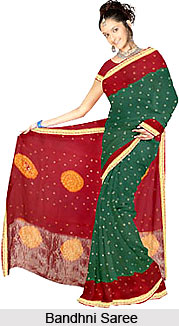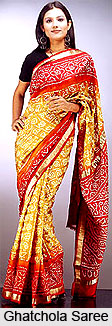 Bandhani sarees are a form of Indian saree that are highly coveted in all parts of India for the unique designs that are created with tie and dye technique. The small resist-dyed `spots` produce elaborate patterns over the fabric and is mainly created in Gujarat.
Bandhani sarees are a form of Indian saree that are highly coveted in all parts of India for the unique designs that are created with tie and dye technique. The small resist-dyed `spots` produce elaborate patterns over the fabric and is mainly created in Gujarat.
Bandhani is believed to have existed in India since, at least, the late fifth century AD because such work is evident in the fabrics depicted in the Ajanta murals. Many of today`s western Indian bandhej (bandhani crafts people) trace their ancestry back to Pakistan`s Sind and Punjab. Most traditional bandhej belong to either Khatri, Chhipa (printing), Punjabi Chavda, Rangrez (dyer) or Neelgar (indigo dyer) communities. In fact, about nine totally different social groups are involved with the production of traditional Bandhani textiles.
Bandhani sarees and odhnis were worn by women of all religions, castes and tribes, and were made of cotton, mulberry silk, and even wool in the case of some ethnic odhnis. As per the historical evidences, the first Bandhani saree was worn at the time of Bana Bhatt`s Harshacharita in a royal marriage. It was believed that wearing a Bandhani saree can bring good future to a bride. Ajanta walls stand for the evidences of these Bandhani sarees. In recent times, the traditional Bandhani market has shrunk due to the constant rise of low-cost silk-screened imitations. Most modern Bandhani sarees are made with larger designs and fewer ties than in the past. Yet even today many different ethnic and tribal groups still wear odhnis with specific colours and designs, and Bandhani sarees are traditionally worn by wealthier, often urban, women for special occasions, including weddings.
 Bandhani sarees are the traditional sarees of West India and the most important manufacturing centres of this sarees are located in Jamnagar (Saurashtra), Bhuj (Kutch) and Ahmedabad (central Gujarat). These are some of the major industrial textile centres of India where many rural craftspeople migrate for work. Jhunjhunu, Sikar, Bikaner, Jodhpur and Jaipur (Rajasthan) are also known for creating these exclusive sarees. The designs of Bandhani sarees fall into five main categories that include several processes to follow. These types of sarees are created by combining different vibrant colours. Some sarees are created by contrasting two colours with borders, endpieces and one or more large central medallion called a `pomcha` or `padma` (lotus flower). Basically red and black are used for creating a combination but other pairs of colours are also found. For instance, the Panetar saree is a Gujarati Hindu wedding saree of satin-weave Gajji silk with red borders, central medallions and a white body. These sarees may contain regularly spaced red tie-dyed spots.
Bandhani sarees are the traditional sarees of West India and the most important manufacturing centres of this sarees are located in Jamnagar (Saurashtra), Bhuj (Kutch) and Ahmedabad (central Gujarat). These are some of the major industrial textile centres of India where many rural craftspeople migrate for work. Jhunjhunu, Sikar, Bikaner, Jodhpur and Jaipur (Rajasthan) are also known for creating these exclusive sarees. The designs of Bandhani sarees fall into five main categories that include several processes to follow. These types of sarees are created by combining different vibrant colours. Some sarees are created by contrasting two colours with borders, endpieces and one or more large central medallion called a `pomcha` or `padma` (lotus flower). Basically red and black are used for creating a combination but other pairs of colours are also found. For instance, the Panetar saree is a Gujarati Hindu wedding saree of satin-weave Gajji silk with red borders, central medallions and a white body. These sarees may contain regularly spaced red tie-dyed spots.
Besides these, the artisans of this region create sarees with a single ground colour and multicoloured tie-dyed spots which are common among certain ethnic groups. Dark blue or black grounds are generally used and after the application of paler dyes, these sarees are dyed in successive indigo baths. Single-colour sarees with white spots are also common among the people of West India. The most famous of this type is the Gujarati saree called the Gharchola. It is usually red but occasionally green, and is divided into a network of squares created by rows of white tie-dyed spots or woven bands of zari. Single motifs are also created within each compartment. Usually elephants, dancing girls, parrots and flowers, sometimes with discontinuous supplementary-weft zari are woven in the sarees to give the sarees an ethnic look. The Gharchola is a traditional Hindu and Jain wedding saree. In earlier times, these were made of cotton but are now usually silk is used to create the sarees. Another type of Bandhani sarees are also perceptible in Rajasthan, which are created by tying the entire length of cloth rather than tiny sections. This produces diagonal stripes of bright colours called lahariya (waves). These sarees were traditionally given as gifts during the festivals of Holi and Teej.
Apart from creating a wide variety in the Bandhani sarees, the artisans include a distinct process. In this process, the sarees are given a touch of multicoloured stripes (patadar) in the border and endpiece. This is created through successive dip-dyeing into different dye baths. The number of tie-dyed spots in these sarees is usually very small. Bandhani spots are given a variety of names. Some relate more to size than shape, such as very small spots without a dark centre are called bindi. Other names refer to the shape of the spot, such as `kori` (cowrie shell) for a tear-drop shape; `chundadi` for round spots and `ghatadi` for square. These spots are often found in traditional Rajasthani kaledar odhni tied in regular geometric patterns. Large square or circular spots with multiple layers of coloured concentric rings called `laddu jalebi` (coloured sweets) or `dabbi` (small box) are also found in the `kaledar`. Another group of small spots tied closely together to form a block of colour is called a `matichar`.
The Bandhani sarees are created keeping in mind the traditional background of the country. These sarees are often created for special and ritual occasions. The artisans create special Raksha bandhan sarees that are given to a Gujarati woman by her brother during Raksha Bandhan. This saree was created on silk satin in the late nineteenth century, in Saurashtra. The artisans often create traditional Rajasthani Bandhani saree with dyeing in traditional local colours with white spots (churi). These sarees are block-printed in the border and screen-printed in the field and are well admired by the women of West India.
Bandhani sarees have been carrying the tradition of west India since a long age. The artisans of this region create traditional Bandhani sarees a well as various dress materials that manifest the exquisite artistry.





















